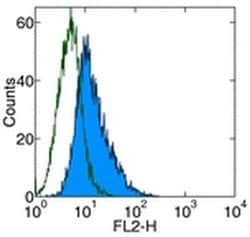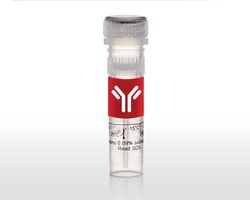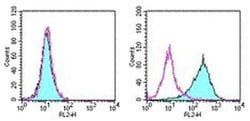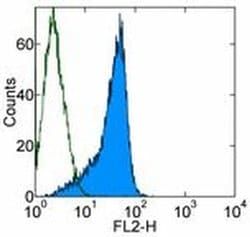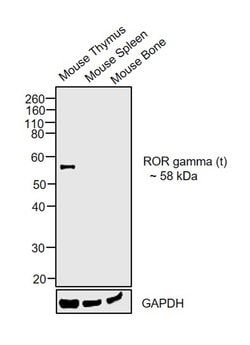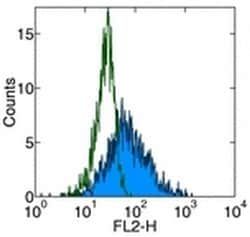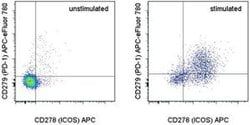Nur77 Monoclonal Antibody (12.14), PerCP-eFluor™ 710, eBioscience™, Invitrogen™
Manufacturer: Invitrogen
Select a Size
| Pack Size | SKU | Availability | Price |
|---|---|---|---|
| Each of 1 | 50-112-8999-Each-of-1 | In Stock | ₹ 36,757.00 |
50-112-8999 - Each of 1
In Stock
Quantity
1
Base Price: ₹ 36,757.00
GST (18%): ₹ 6,616.26
Total Price: ₹ 43,373.26
Antigen
Nur77
Classification
Monoclonal
Concentration
0.2 mg/mL
Formulation
PBS with 0.09% sodium azide; pH 7.2
Gene Accession No.
P12813
Gene Symbols
NR4A1
Purification Method
Affinity chromatography
Regulatory Status
RUO
Gene ID (Entrez)
15370
Content And Storage
4° C, store in dark, DO NOT FREEZE!
Form
Liquid
Applications
Flow Cytometry
Clone
12.14
Conjugate
PerCP-eFluor 710
Gene
NR4A1
Gene Alias
early response protein NAK1; Gfrp; GFRP1; growth factor-inducible nuclear protein N10; Hbr1; Hbr-1; Hmr; hormone receptor; immediate early gene transcription factor NGFI-B; MGC9485; N10; NAK1; NAK-1; nerve growth factor IB nuclear receptor variant 1; nerve growth factor induced protein I-B; nerve growth factor-induced protein I-B; Ngfib; NGFI-B; NP10; Nr4a1; Nuclear hormone receptor NUR/77; nuclear protein N10; Nuclear receptor subfamily 4 group A member 1; nuclear receptor subfamily 4, group A, member 1; NUR77; Orphan nuclear receptor HMR; orphan nuclear receptor TR3; Orphan receptor tr3; ST-59; steroid receptor TR3; testicular receptor 3; TIS1; TR3; TR3 orphan receptor
Host Species
Mouse
Quantity
100 μg
Primary or Secondary
Primary
Target Species
Mouse
Product Type
Antibody
Isotype
IgG1 κ
Description
- Description: This 12.14 monoclonal antibody reacts with mouse Nur77 (also known as NR4A1, TR3, NGFI-B, or NAK1), an inducible orphan nuclear receptor
- Expressed in thymocytes and T cell lines, Nur77 promotes apoptosis and plays a role in thymocyte negative selection
- Additionally, Nur77 has been shown to be critical for steroid biosynthesis in Leydig cells as well as for the effects of dopamine
- In addition, Nur77 has been shown to interact with FoxP3 in regulatory T cells
- However, our results with this antibody do not correlate with this observation
- Applications Reported: This 12.14 antibody has been reported for use in intracellular staining followed by flow cytometric analysis
- Applications Tested: This 12.14 antibody has been tested by intracellular staining followed by flow cytometric analysis of stimulated mouse thymocytes using the Foxp3/Transcription Factor Staining Buffer Set (cat
- 00-5523) and protocol
- Please refer to Best Protocols: Protocol B: One step protocol for (nuclear) intracellular proteins located under the Resources Tab online
- This can be used at less than or equal to 0.125 μg per test
- A test is defined as the amount (μg) of antibody that will stain a cell sample in a final volume of 100 μL
- Cell number should be determined empirically but can range from 10^5 to 10^8 cells/test
- It is recommended that the antibody be carefully titrated for optimal performance in the assay of interest
- NR4A1 is a member of the steroid-thyroid hormone-retinoid receptor superfamily
- NGFI-B-alpha is expressed in brain, adrenal, thyroid, liver, testis, ovary, thymus, muscle, lung and prostate
- Its expression is induced in response to various stress stimuli and growth factors
- The encoded protein acts as a nuclear transcription factor involved in mediating apoptotic signaling in thymocytes and tumor cells, as well as having a role in signaling in the hypothalamic-pituitary axis
- Translocation of the protein from the nucleus to mitochondria induces apoptosis
- Three transcript variants encoding two distinct isoforms have been identified for this NR4A1
- Variant (3), also known as TRC beta, contains multiple differences compared to variant 1
- The resulting isoform b contains a shorter and distinct C-terminus compared to isoform a
- RXR has been shown to be a partner for NR4A1.

